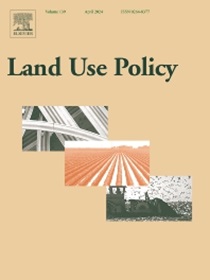Harmonization potential of the fragmented farmlands in Finland: The pros and cons for critical parcel characteristics
IF 6
1区 社会学
Q1 ENVIRONMENTAL STUDIES
引用次数: 0
Abstract
Agricultural landscapes have been shaped by gradual, partially optimized changes in farms and surrounding areas which have resulted in fragmented agricultural landownership and increased distances on farms. Since Finland joined the EU in 1995, the average farm size has more than doubled which has increased the distances on farms. This may have caused trade-offs with resource use efficiency, productivity, and sustainability. The aim of this study was to evaluate the potential and impacts of land reallocation by integrating regional variability, logistical factors, and emerging satellite imagery, with an emphasis on enhancing resilience in future climates. This study estimated the theoretical potential for land reallocation between farms to reduce farmland fragmentation but also applied fixed land exchange rates (5 % to 40 %) with the primary aim to reduce distances within each farm depending on the farm size and region. The aim was also to identify co-benefits and trade-offs on the number of parcels in a farm, the production capacity of exchanged parcels, diversification potential, and the proximity of parcels to waterways. While keeping the farm size constant, large potential was found to optimize fragmented landscapes and reduce distances within farms especially on large farms. However, only a moderate exchange rate of 5 % almost halved the distances in the best cases of the farms, while exchange rates >20 % provided less additional logistic benefits. Thereby, modest, well targeted measures are not only more acceptable to landowners but may provide the most benefits with fewer trade-offs. In unsatisfactory cases, large parcels were replaced by higher numbers of smaller ones, productivity differences occurred, and closer parcels became more uniform, which may reduce diversification options, which are important for resilience and sustainability. Hence, merging and reshaping nearby parcels after reallocation might be needed to complete rationalization. Estimated changes in the proximity of the parcels to waterways tended to improve the farmers’ readiness to implement irrigation as an adaptation measure to climate change. The variable outcome of parcel reallocation emphasizes the central role of the current customer-driven consolidation system chaired by independent land surveyors to boost the land reallocation also in the future to improve logistics, resource efficiency, and sustainability on farms that today struggle with cost-crises.
芬兰分散农田的统一潜力:关键地块特征的利弊
农业景观是由农场和周边地区部分优化的渐进变化形成的,这种变化导致了农业土地所有权的分散和农场间距离的增加。自 1995 年芬兰加入欧盟以来,农场的平均规模扩大了一倍多,这也增加了农场之间的距离。这可能会导致资源利用效率、生产率和可持续性之间的权衡。本研究的目的是通过整合区域变异性、物流因素和新出现的卫星图像,评估土地重新分配的潜力和影响,重点是提高在未来气候中的适应能力。本研究估算了农场间土地重新分配的理论潜力,以减少农田破碎化,但也采用了固定的土地交换率(5% 至 40%),主要目的是根据农场规模和区域缩小每个农场内部的距离。此外,还旨在确定农场内地块数量、交换地块的生产能力、多样化潜力以及地块与水道的距离等方面的共同利益和权衡。在农场规模保持不变的情况下,我们发现巨大的潜力可以优化破碎的地貌,减少农场内部的距离,尤其是在大型农场。不过,在最好的情况下,只有 5% 的适度汇率能将农场内的距离缩短近一半,而 20% 的汇率带来的额外物流效益则较小。因此,适度、有针对性的措施不仅更容易被土地所有者接受,还能以较少的权衡带来最大的收益。在不理想的情况下,大块地块被更多的小块地块取代,出现了生产率差异,距离较近的地块变得更加一致,这可能会减少多样化选择,而多样化选择对于复原力和可持续性非常重要。因此,可能需要在重新分配后合并和重塑附近的地块,以完成合理化。估计地块与水道距离的变化往往会提高农民实施灌溉作为适应气候变化措施的意愿。地块重新分配的可变结果强调了当前由独立土地测量员主持的客户驱动整合系统的核心作用,该系统未来还将促进土地重新分配,以改善物流、资源效率和目前在成本上涨中挣扎的农场的可持续性。
本文章由计算机程序翻译,如有差异,请以英文原文为准。
求助全文
约1分钟内获得全文
求助全文
来源期刊

Land Use Policy
ENVIRONMENTAL STUDIES-
CiteScore
13.70
自引率
8.50%
发文量
553
期刊介绍:
Land Use Policy is an international and interdisciplinary journal concerned with the social, economic, political, legal, physical and planning aspects of urban and rural land use.
Land Use Policy examines issues in geography, agriculture, forestry, irrigation, environmental conservation, housing, urban development and transport in both developed and developing countries through major refereed articles and shorter viewpoint pieces.
 求助内容:
求助内容: 应助结果提醒方式:
应助结果提醒方式:


